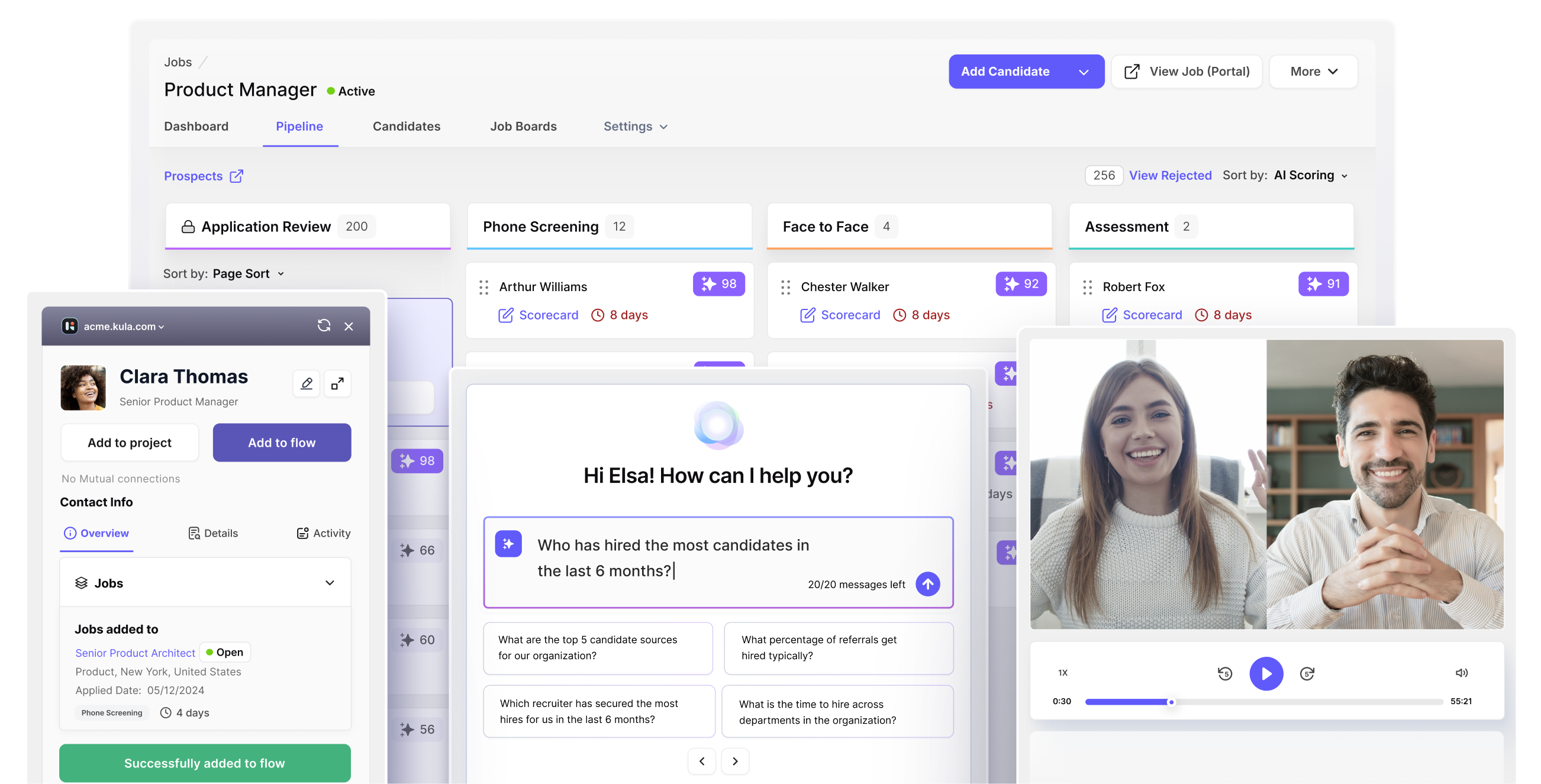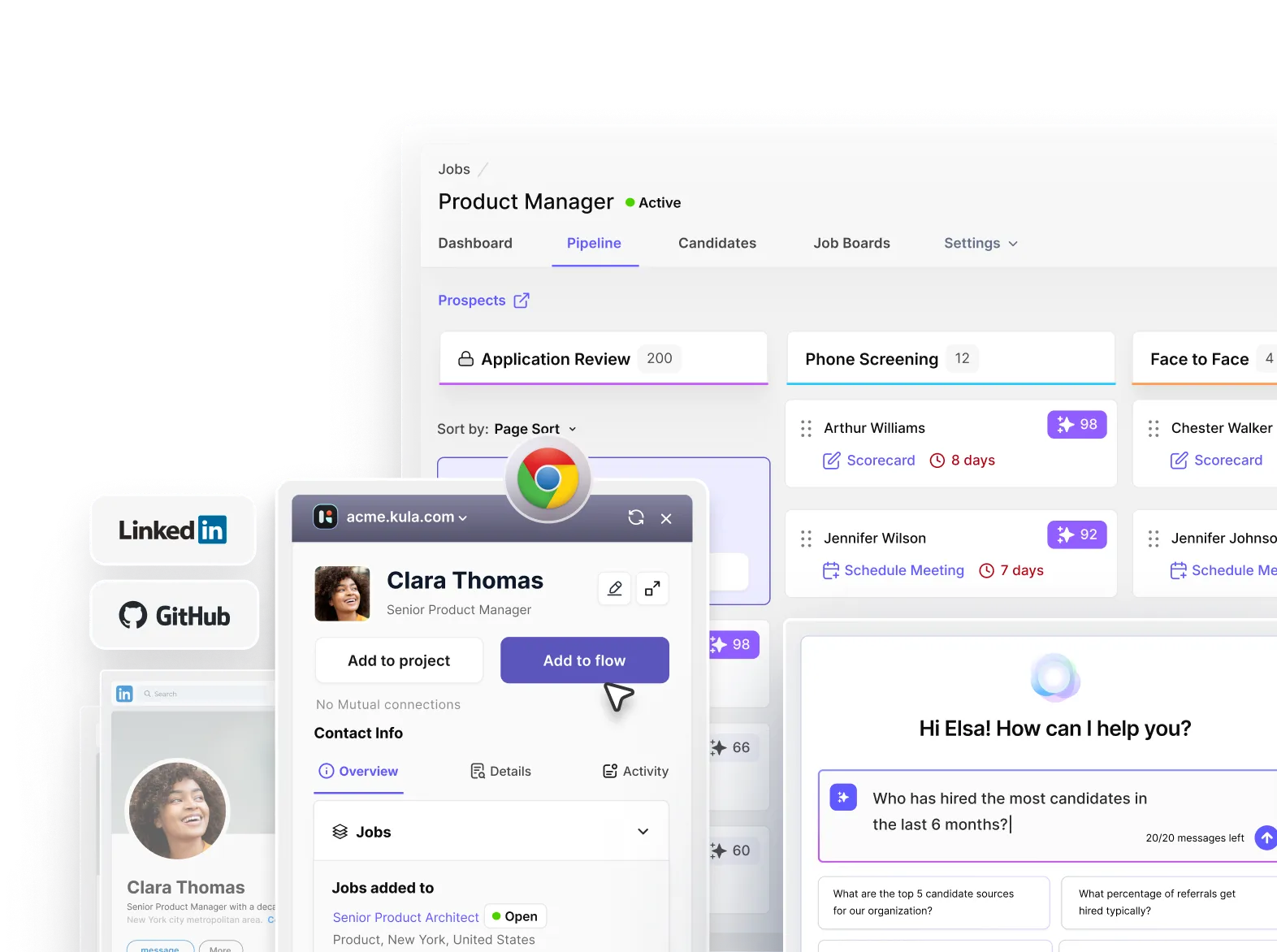Book a 30-minute demo and learn how Kula can help you hire faster and smarter with AI and automation
According to SHRM HR benchmarking data, an empty desk can cost you over $4,700 and more than 44 days of lost productivity.
When hiring decisions are based more on intuition than data, organizations are unable to do the following things:
- Identify the true top performers among a flood of applicants
- Gain visibility into which sourcing channels work best
- Fine-tune selection methods that yield the best hires
- Optimize hiring processes, frustrating candidates and hiring managers alike
This leads to two core problems: wrong hires, which cost $17,000 per employee, and an even longer, more expensive hiring process.
So, if you don't take action now, guesswork will plunge your business into a hiring and rehiring cycle.
To handle this, staffing agencies, startups, SMBs, and healthcare firms are using data-driven recruiting.
Let's look at what that is, its benefits, and how you can get started.
What is data-driven recruiting?
Data-driven recruiting is an approach that takes in data and metrics, analyzes them to draw insights, and then applies those insights to improve your existing recruiting process.
With data-driven recruiting, companies access accurate answers to key hiring questions such as:
- Which channels yield high-quality candidates?
- How long does it usually take to fill a position, and what is slowing us down?
- What is the ROI for different recruitment activities and channels?
- How diverse is our candidate pool compared to the available talent market?
- Which aspects influence someone to accept our offer or stay with us for a long time?
Here is how data-driven recruiting helps with hiring:
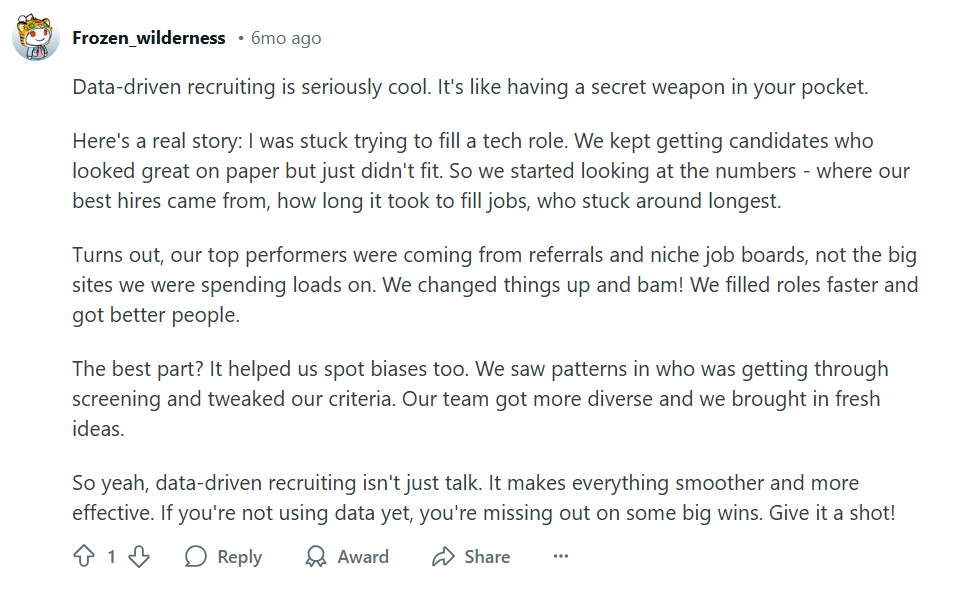
How to build a data-driven hiring process
Step 1: Identify key recruiting metrics for success
Evaluate your business objectives and recruiting goals to select meaningful KPIs and metrics for analyzing data.
Also, obtain detailed reports on hiring team performance and hiring stages to identify strengths, weaknesses, and key metrics for optimizing your strategy.
Here's an example of how this process looks:

Some examples of important recruiting KPIs include:
- Time-to-fill: Total number of days it takes for a role to open up to offer acceptance.
- Applicant-to-hire ratio: Derived by dividing the number of hires made over a certain period by the total number of applicants received for a given position
- Source of hire: Refers to percentages showing where successful candidates were sourced from.
- Cost-per-hire: All costs incurred during recruitment are divided by the number of employees recruited within a set timeframe
- Quality-of-hire: Measures how well new employees perform their duties based on productivity levels while working there, but it could also involve engagement or retention rates
Step 2: Use an ATS for seamless hiring
Once you know which data points are relevant, your next move should be to decide on the applicant tracking system that speeds up your hiring process with accurate data-driven insights.
Kula adapts to your needs, allowing you to:
- Create customized hiring stages to create a recruiting process as per specific hiring needs. For example, you can create new stages like “take-home assessment” or “reference check.”
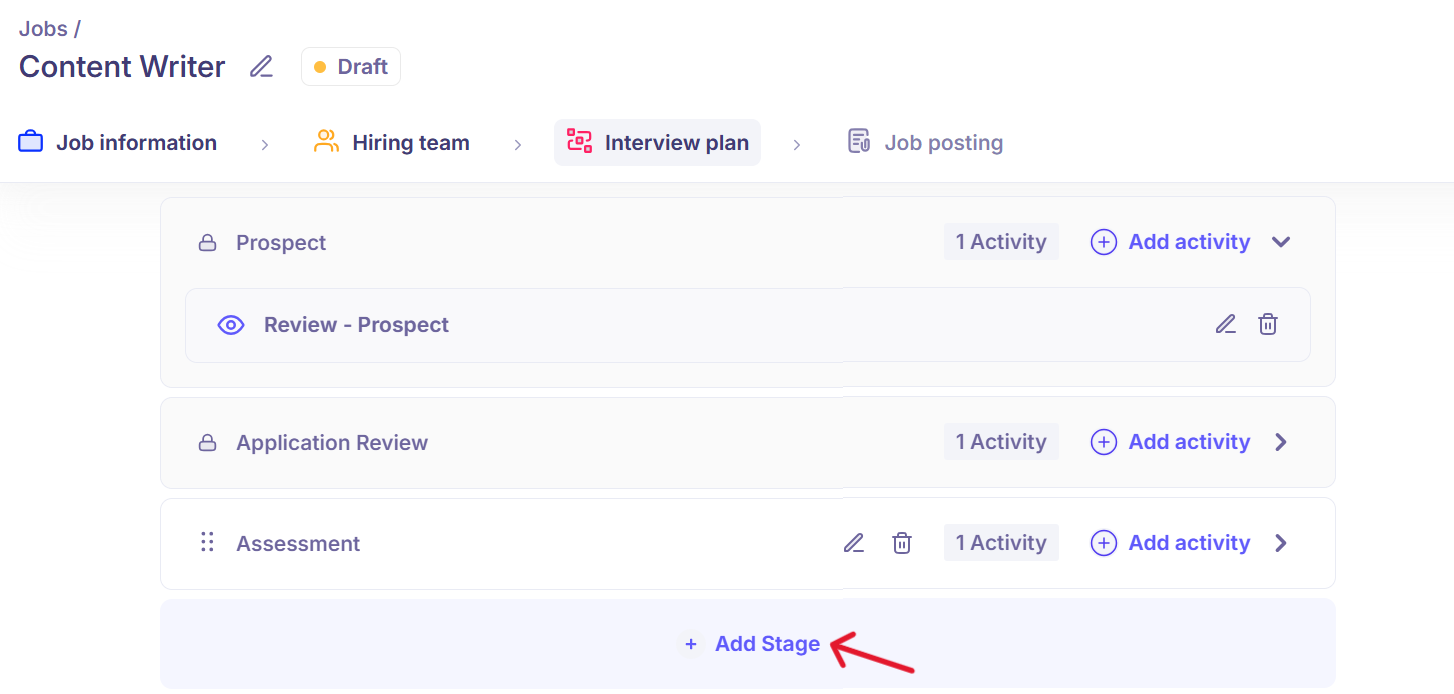
- Set up automated communication flows to keep your candidates engaged. For example, suppose a candidate does not finish their application within 48 hours, automatically send them a follow-up email.

- Use AI right from the application to the interview stages, and create candidate status corresponding to various phases such as screening, interviewing, and accepting or rejecting offers.
- Access Kula Analytics for visual reports on all the important recruiting metrics and KPIs. Kula Analytics dashboard centralizes all your data in one place and provides 100+ actionable hiring insights.
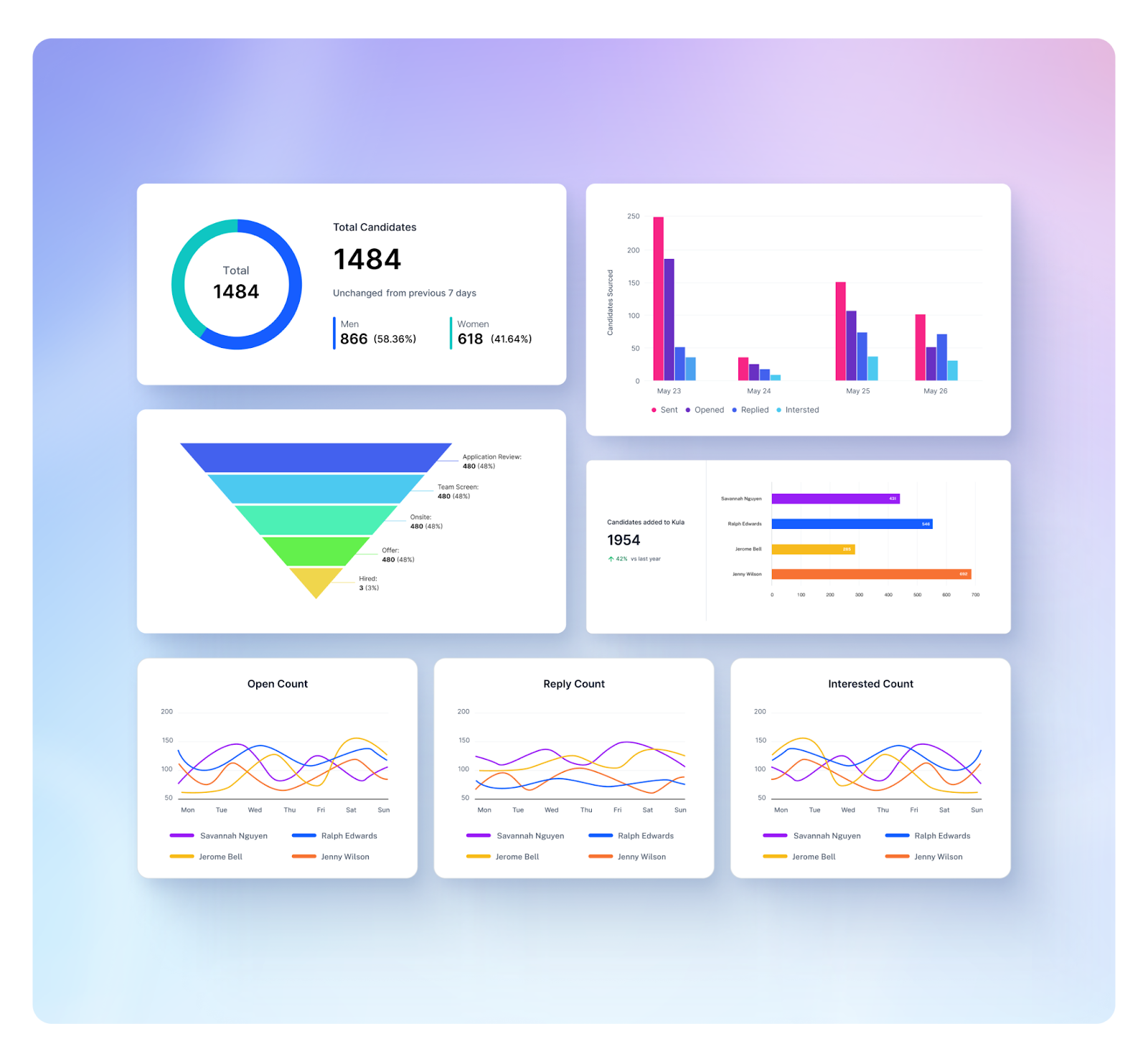
To see Kula in action, you can schedule a personalized demo now, and understand if Kula is the right solution for your hiring needs.
Step 3: Schedule regular reviews of recruiting dashboards
To get the most out of your ATS dashboards, host sessions where recruiting teams can review them with key stakeholders. This will help them identify trends, discuss insights, and brainstorm potential process optimizations for better results.
To make reviews more actionable, categorize your goals into short-term and long-term objectives. Short-term goals might include reducing bottlenecks in interview scheduling, while long-term goals could focus on improving candidate retention.
Step 4: Keep reiterating the process
Data-driven recruitment should be approached with an attitude of continuous improvement.
As you implement changes based on your data, monitor your metrics closely to see if they have the desired effect. If not, feel free to pivot and try something else.
The beauty of data-driven recruiting is that you can make decisions based on evidence rather than guesswork.
Over time, this iterative approach will help you fine-tune your recruitment engine and achieve better outcomes with less effort. Certain sourcing channels or assessment methods consistently outperform others, allowing you to double down on what works and eliminate what doesn't.
What do data-driven recruiting results look like
Yes, implementing data-driven recruiting requires initial effort. Establishing processes can have a learning curve and potential up-front costs, but the investment is worth it!
Let's go over the benefits you can expect to enjoy with data-driven recruiting via an AI-driven, all-in-one hiring platform like Kula:
1. Improved quality of hire
Good quality hires drive business results. But how do you make sure you're hiring qualified candidates?
When you track key metrics like the percentage of top performers, turnover rates, and sources of these hires, you know what you did differently with qualified candidates compared to others.
You can track all these metrics and access visual reports in Kula dashboards. This way, you can use recruiting data to create repeatable hiring processes that have already helped you attract top talent.
For instance, you use Kula Analytics for your next senior software hire and find that referral candidates perform 20% better and have 25% lower turnover than job board hires. Now you know that your recruiting efforts must be redirected to getting referred applicants and cutting costs for job board advertising.
You can also add more effectiveness to these referred applications with:
- Kula's AI Scoring—evaluates candidates based on their skills, education, experience, and resume inputs with the highest standards of fairness and transparency.
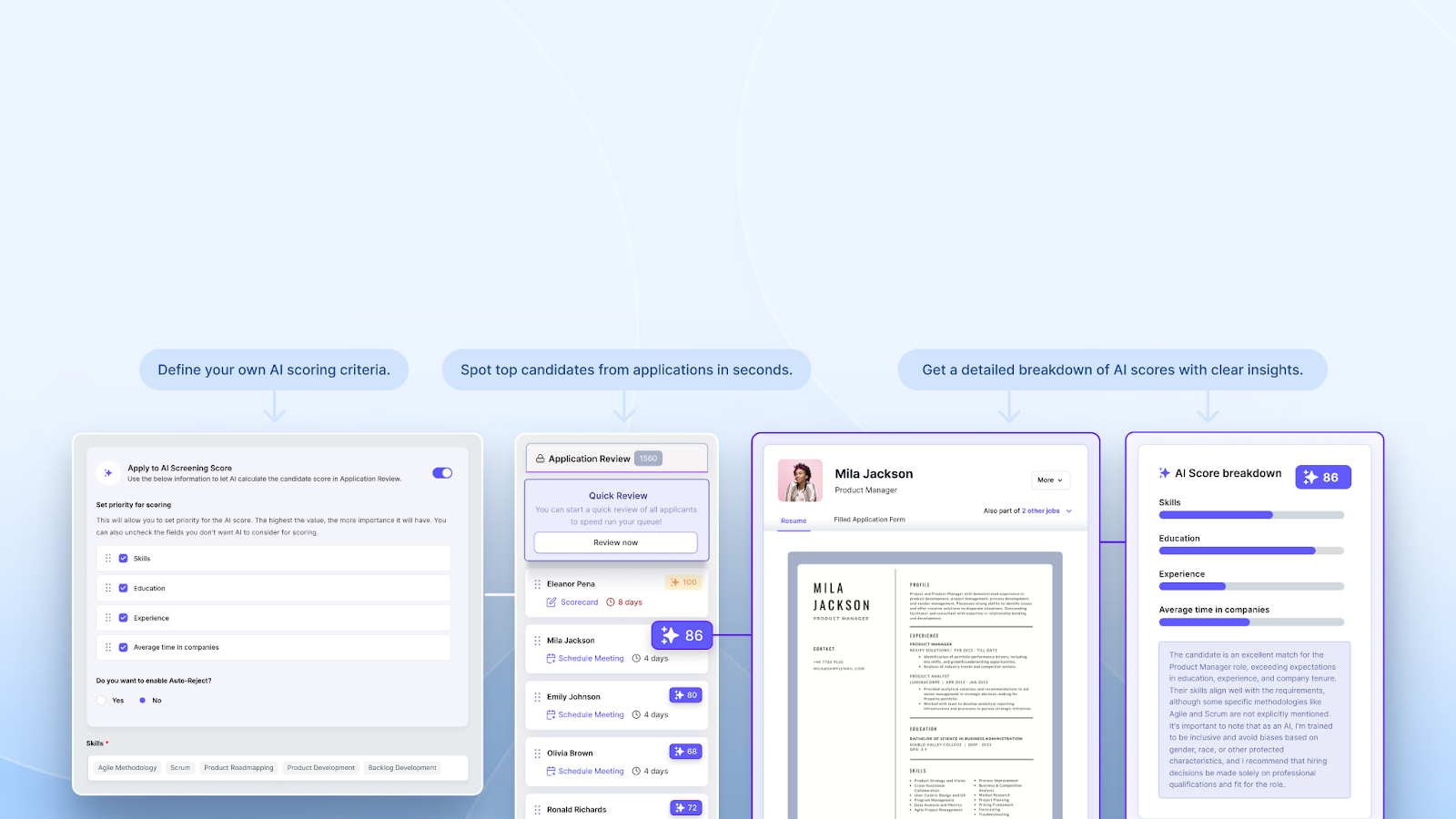
- Kula Interview Intelligence—automatically transcribes conversations and summarizes key points, and real-time scorecards for faster and accurate feedback.
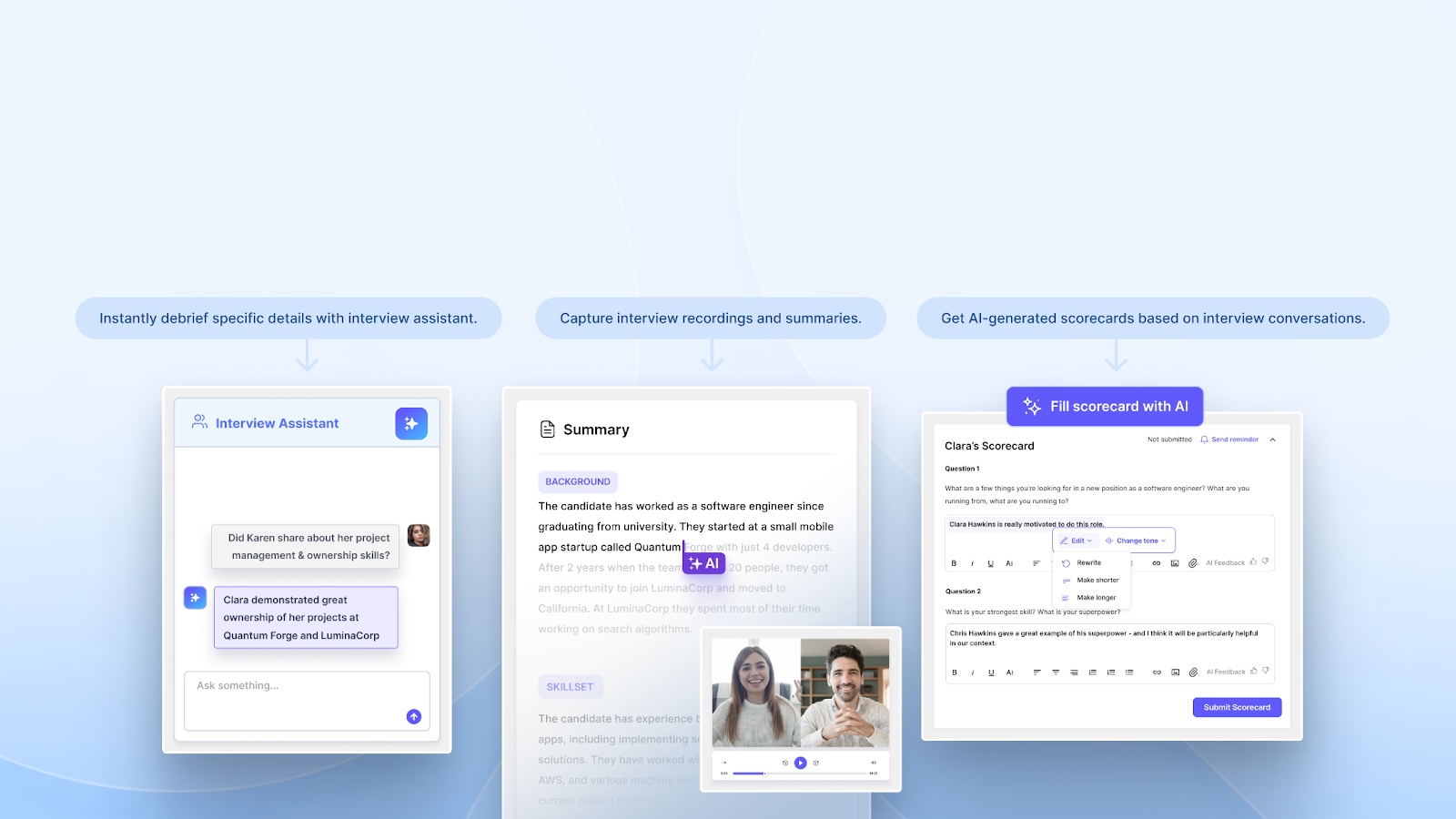
2. Decreased time-to-hire rates and total expenditure per hire
A data-driven approach to recruiting helps you save both time and money by helping you identify the right talent pools and address bottlenecks early.
For example, if hiring for engineering roles takes an average of 45 days and data shows that interviews are the biggest bottleneck, companies can take targeted action to streamline the process. By focusing on interview efficiency, they can directly reduce time-to-hire.
Instead of manually reviewing each stage of your hiring process, use the ATS tool to generate detailed reports on cost-per-hire, time spent at each stage, and source effectiveness to optimize your recruiting and make smarter hiring decisions.
Also, some ATS tools keep tabs on your spending in every category—from job board contracts to background checks—so you can pinpoint and cut unnecessary costs and redirect that money into ROI-inducing recruiting efforts.
3. Enhanced candidate experience
Candidate experience directly affects hiring success rates.
A positive candidate experience helps attract more qualified candidates and cements your reputation as an employer of choice.
When you collect and analyze candidate data, you also get more information on applicants' struggles.
For example, suppose candidates drop off applications due to the high number of questions. In that case, you should work on simplifying your job application to get more prospects and not lose qualified candidates.
Follow these best practices to enhance the candidate experience:
- Create brand-aligned career pages for your next job postings so highly qualified candidates feel the impact of your professionalism
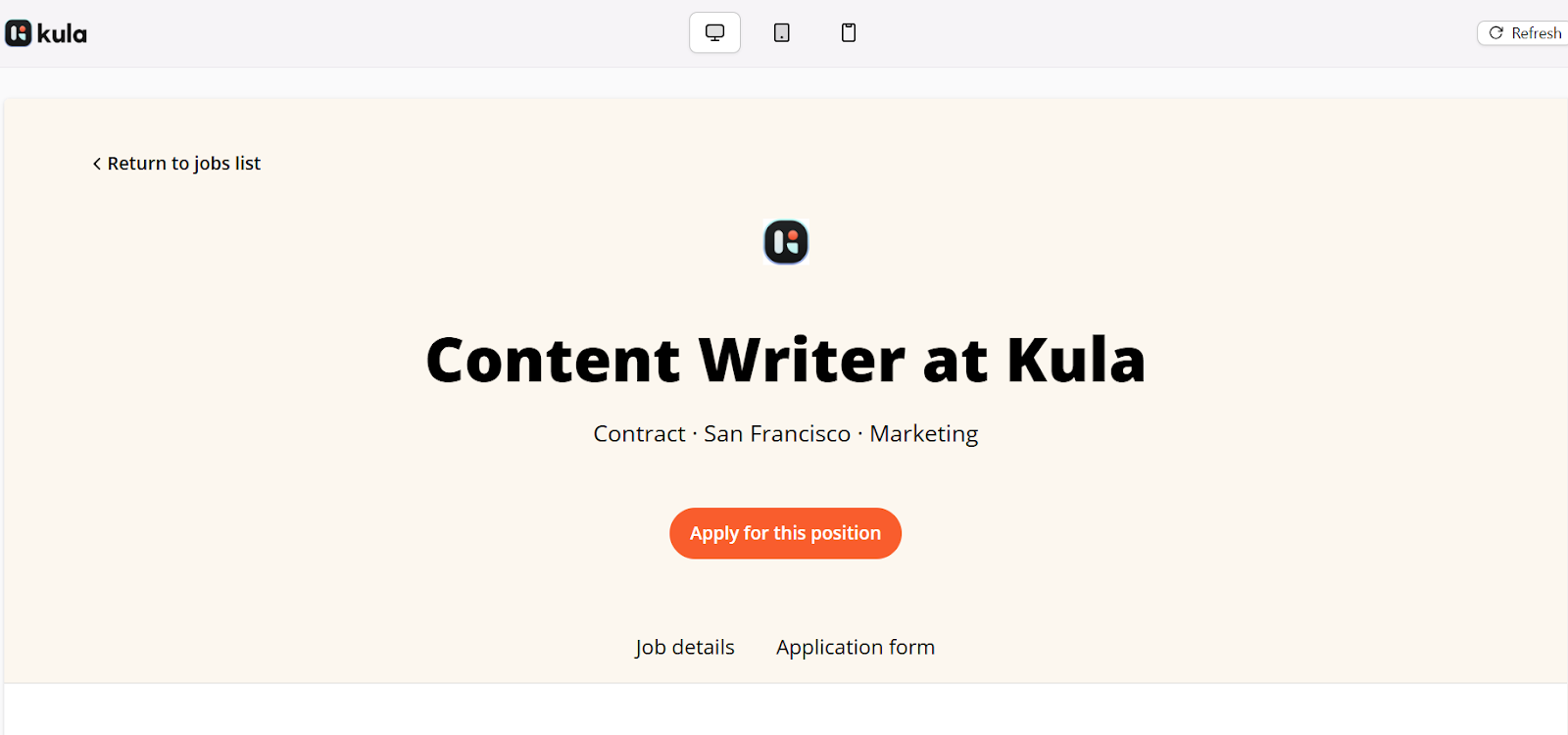
- Create a mobile-friendly application so your candidates can fill out application forms with a few clicks on their smartphones
- Use personalized outreach sequences to create communication for full-cycle recruiting. It helps companies keep candidates engaged throughout the recruitment process

4. Advanced workforce planning
Workforce planning is a forward-thinking approach that almost every high-growth company must have. Instead of filling positions at the last minute, you need a proactive approach to the recruiting process.
Data-driven recruiting is the only way to do it.
When you use the ATS dashboard, it gives you complete visibility of how many roles are needed for every department or location and allows you to monitor progress toward those numbers.
Select an ATS that integrates easily with your HRIS, so hiring teams are always up-to-date with the organization's structure and headcount.
For instance, if you set a sales personnel target of hiring 50 people by the end of the third quarter, Kula ATS can tell you how likely you will reach this goal on time. If it is unlikely, it will prompt you to intensify your sourcing methods instead of leaving you scrambling to meet goals with the wrong hires at the very last second.
5. Supports diversity goals
Creating a diverse workforce is a top priority for most organizations today, and data collection helps pinpoint areas for improvement in this KPI. With the correct data, companies can also measure the impact of diversity initiatives.
Kula offers diversity dashboards that track gender, race/ethnicity, and veteran status by stage in your hiring funnel.
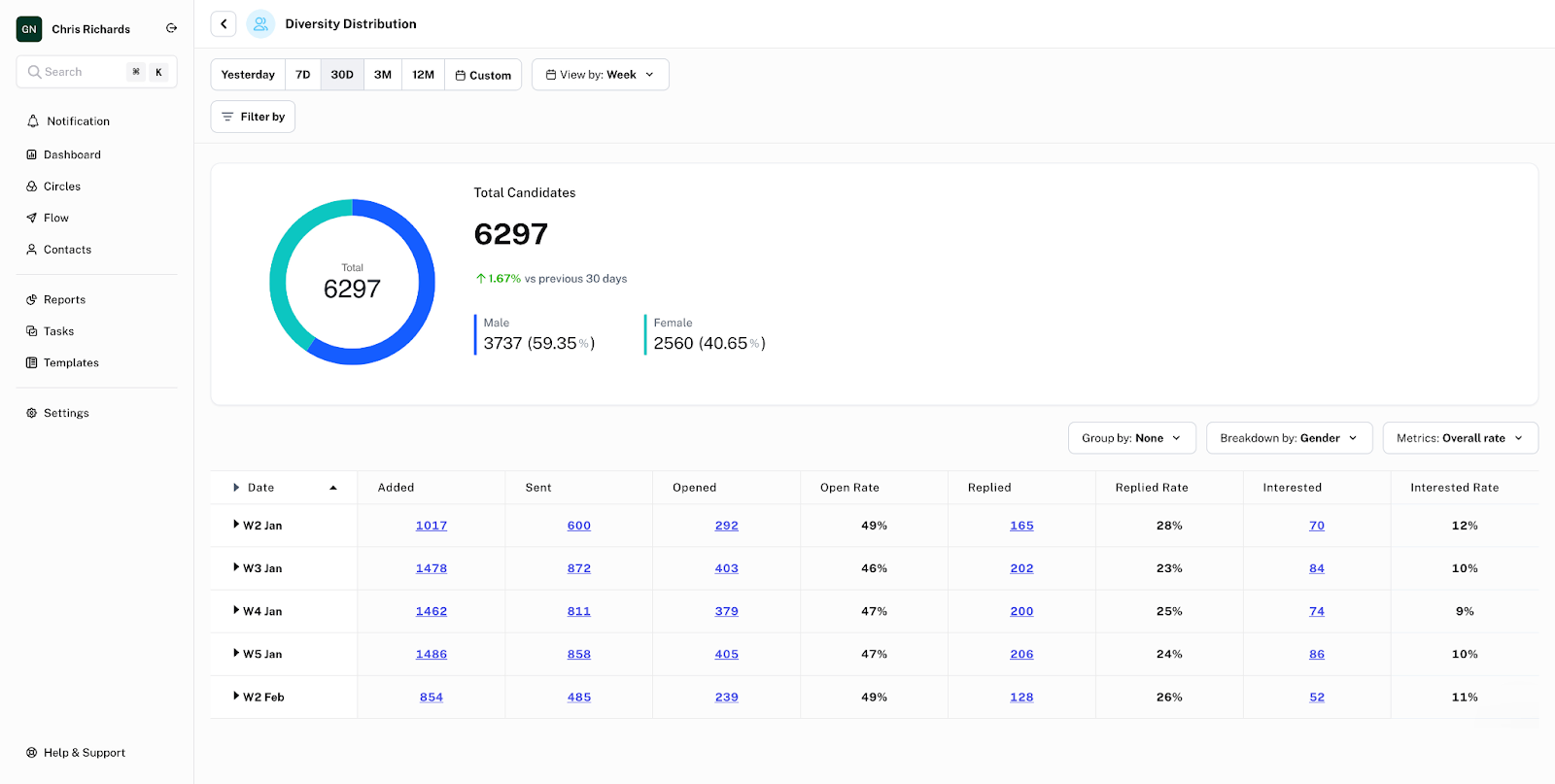
Our analytics dashboard provides real-time visibility into the demographic breakdown of your candidate pool at each stage in the hiring funnel so you can see where drop-offs are occurring and take corrective actions if necessary.
It's easy with Kula ATS to remain compliant with EEOC & OFCCP reporting to meet all legal requirements. Here's how:
- Anonymized screening: To combat unconscious bias at the earliest stage of the selection process, Kula allows you to hide certain identifying information (such as name, gender, or age) from recruiters until after they have reviewed an applicant's qualifications.
- Objective assessments: Kula offers pre-employment tests and interview questions that are scientifically validated for predicting job performance—regardless of a candidate's background or demographic characteristics.
To keep it short
Data-driven recruiting is your solution if you are looking to optimize your hiring process to achieve specific results.
Once you have evaluated business goals and selected relevant recruiting metrics, you can use an ATS to record and track data.
Kula ATS is an AI-powered tool that provides all the recruiting analytics needed to make hiring easy and efficient.
Find out what Kula can do for you! Book a demo today to discover if it's the right fit for your hiring needs.





















